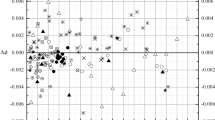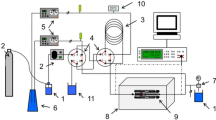Abstract
The analysis by Wang et al. (J. Solution Chem. 35:1137–1156, 2006) of the osmotic and activity coefficients of fourteen of the aqueous rare earth trichlorides at the temperature 298.15 K is based mainly on the isopiestic results reported by Spedding et al. (J. Chem. Eng. Data 21:341–360, 1976) and Rard and Spedding (J. Chem. Eng. Data 27:454–461, 1982), but corrected for more recent critical reviews of the osmotic coefficients of the KCl(aq) and CaCl2(aq) reference solutions used in these measurements. Also included were the potential difference (emf) measurements by Malatesta et al. (Phys. Chem. Chem. Phys. 4:121–126, 2002) for LaCl3(aq) using cells with a liquid ion-exchange membrane electrode and earlier results for concentration cells with transport for the rare earth trichlorides. Our reexamination of osmotic coefficients calculated from these potential differences of cells with a liquid ion-exchange electrode indicates their values are skewed relative to osmotic coefficients obtained more directly from the isopiestic measurements, being significant higher for molalities between (0.025 and 0.3) mol·kg−1 and significantly lower at higher molalities. As a consequence, the combined results yielded mean, molality-based, activity coefficients that are systematically too large for the light and intermediate rare earths. Although restricted to a narrower molality region of about (0.02–0.04) mol·kg−1, potential difference measurements for aqueous rare earth trichlorides from concentration cells with AgCl(s) electrodes appear to yield more reliable results. The extended ion-interaction model parameters of Wang et al. have been reevaluated using the cited isopiestic results together with osmotic coefficients derived from the concentration cells with transport as reported by Spedding et al. (J. Chem. Eng. Data 21:341–360, 1976). Mean activity coefficients calculated using these new model parameters should be more accurate than those previously reported.
Similar content being viewed by others
Notes
Equation 2 of reference [11] is missing a factor of \( +_{{}} \{ 2(\nu_{\text{M}} \nu_{\text{X}} )/\nu \} m\beta_{\text{M,X}}^{(1)} {\text {exp}}( - \alpha_{B1} I^{1/2} ) \).
References
Spedding, F.H., Weber, H.O., Saeger, V.W., Petheram, H.H., Rard, J.A., Habenschuss, A.: Isopiestic determination of the activity coefficients of some aqueous rare earth electrolyte solutions at 25 °C. 1. The rare earth chlorides. J. Chem. Eng. Data 21, 341–360 (1976)
Rard, J.A., Spedding, F.H.: Isopiestic determination of the activity coefficients of some aqueous rare earth electrolyte solutions at 25 °C. 6. Eu(NO3)3, Y(NO3)3, and YCl3. J. Chem. Eng. Data 27, 454–461 (1982)
Mason, C.M.: The activity and osmotic coefficients of trivalent metal chlorides in aqueous solution from vapor pressure measurements at 25°. J. Am. Chem. Soc. 60, 1638–1647 (1938)
Pitzer, K.S., Peterson, J.R., Silvester, L.F.: Thermodynamics of electrolytes. IX. Rare earth chlorides, nitrates, and perchlorates. J. Solution. Chem. 7, 45–56 (1978)
Pitzer, K.S.: Ion-interaction approach: theory and data correlation. In: Pitzer, K.S. (ed.) Activity Coefficients in Electrolyte Solutions, Chap. 3, 2nd edn. CRC Press, Boca Raton (1991)
Habenschuss, A., Spedding, F.H.: The coordination (hydration) of rare earth ions in aqueous chloride solutions from X-ray diffraction. III. SmCl3, EuCl3, and series behavior. J. Chem. Phys. 73, 442–450 (1980)
Cossy, C., Helm, L., Powell, D.H., Merbach, A.E.: A change in coordination from nine to eight along the lanthanide(III) aqua ion series in solution: a neutron diffraction study. New J. Chem. 19, 27–35 (1995)
Archer, D.G.: Thermodynamic properties of the NaCl + H2O system II. Thermodynamic properties of NaCl(aq), NaCl·2H2O(cr), and phase equilibria. J. Phys. Chem. Ref. Data 21, 793–829 (1992)
Oakes, C.S., Felmy, A.R., Sterner, S.M.: Thermodynamic properties of aqueous calcium nitrate {Ca(NO3)2} at the temperature 373 K including new enthalpy of dilution data. J. Chem. Thermodyn. 32, 29–54 (2000)
Pitzer, K.S., Wang, P., Rard, J.A., Clegg, S.L.: Thermodynamics of electrolytes. 13. Ionic strength dependence of higher-order terms; equations for CaCl2 and MgCl2. J. Solution Chem. 28, 265–282 (1999)
Wang, Z.-C., He, M., Wang, J., Li, J.-L.: Modeling of aqueous 3–1 rare earth electrolytes and their mixtures to very high concentrations. J. Solution Chem. 35, 1137–1156 (2006)
Archer, D.G.: Thermodynamic properties of the KCl + H2O system. J. Phys. Chem. Ref. Data 28, 1–17 (1999)
Rard, J.A., Clegg, S.L.: Critical evaluation of the thermodynamic properties of aqueous calcium chloride. 1. Osmotic and activity coefficients of 0–10.77 mol·kg−1 aqueous calcium chloride solutions at 298.15 K and correlation with extended Pitzer ion-interaction models. J. Chem. Eng. Data 42, 819–849 (1997)
Malatesta, F., Giacomelli, A., Zamboni, R.: Activity coefficients of electrolytes from the emf of liquid membrane cells: III. LaCl3, K3Fe(CN)6, and LaFe(CN)6. J. Solution Chem. 23, 11–36 (1994)
Malatesta, F., Bruni, F., Fanelli, N.: Activity coefficients of lanthanum salts at 298.15 K. Phys. Chem. Chem. Phys. 4, 121–126 (2002)
Mioduski, T., Gumiński, C., Zeng, D.: IUPAC–NIST solubility data series. 87. Rare earth metal chlorides in water and aqueous systems. Part 1. Scandium group (Sc, Y, La). J. Phys. Chem. Ref. Data 37, 1765–1853 (2008)
Mioduski, T., Gumiński, C., Zeng, D.: IUPAC–NIST solubility data series. 87. Rare earth metal chlorides in water and aqueous systems. Part 2. Light lanthanides (Ce–Eu). J. Phys. Chem. Ref. Data 38, 441–562 (2009)
Mioduski, T., Gumiński, C., Zeng, D.: IUPAC–NIST solubility data series. 87. Rare earth metal chlorides in water and aqueous systems. Part 3. Heavy lanthanides (Gd–Lu). J. Phys. Chem. Ref. Data 38, 925–1011 (2009)
Acknowledgments
The authors thank Professor Zhi-Chang Wang for helpful comments.
Author information
Authors and Affiliations
Corresponding authors
Rights and permissions
About this article
Cite this article
He, M., Rard, J.A. Revision of the Osmotic Coefficients, Water Activities and Mean Activity Coefficients of the Aqueous Trivalent Rare Earth Chlorides at T = 298.15 K. J Solution Chem 44, 2208–2221 (2015). https://doi.org/10.1007/s10953-015-0403-4
Received:
Accepted:
Published:
Issue Date:
DOI: https://doi.org/10.1007/s10953-015-0403-4




